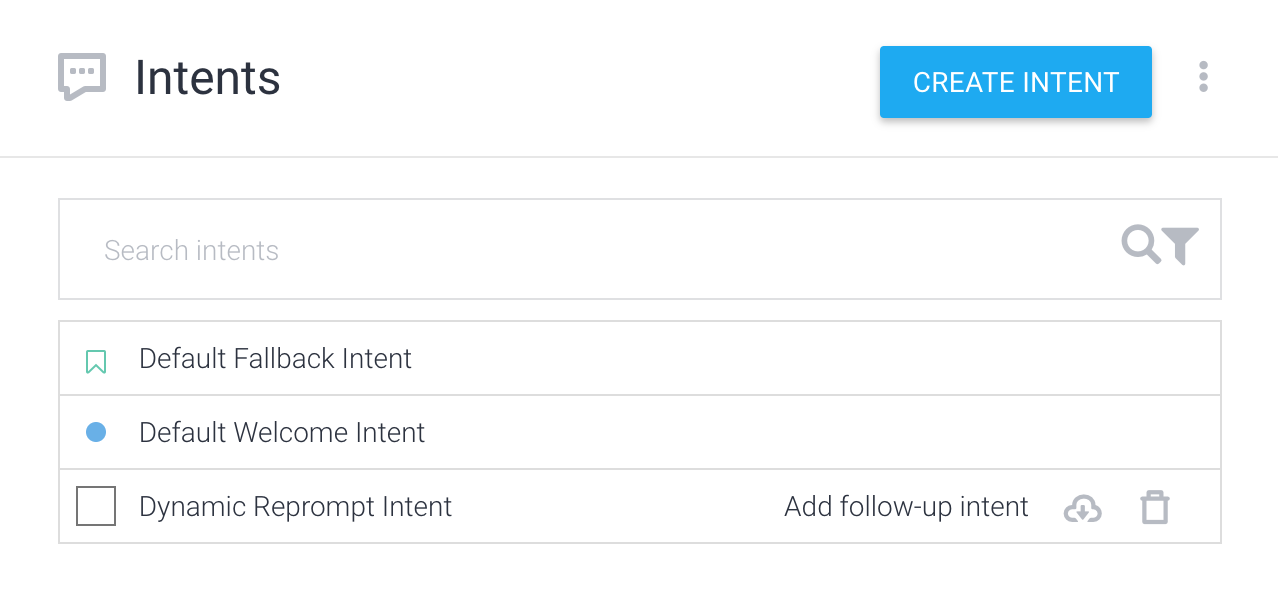Esplora in Dialogflow
Fai clic su Continua per importare il nostro esempio di prompt in Dialogflow. Quindi, segui questi passaggi per eseguire il deployment e testare l'esempio:
- Inserisci il nome di un agente e crea un nuovo agente Dialogflow per l'esempio.
- Al termine dell'importazione dell'agente, fai clic su Vai all'agente.
- Nel menu di navigazione principale, vai ad Fulfillment.
- Attiva l'editor incorporato, quindi fai clic su Esegui il deployment. L'editor contiene il codice di esempio.
- Nel menu di navigazione principale, vai a Integrazioni, quindi fai clic su Assistente Google.
- Nella finestra modale visualizzata, attiva Anteprima automatica delle modifiche e fai clic su Test per aprire il simulatore di azioni.
- Nel simulatore, inserisci
Talk to my test appper testare il campione.
Puoi utilizzare le seguenti funzionalità per gestire i casi in cui gli utenti non forniscono input per le tue Azioni (errori di nessun input):
- Richieste predefinite di sistema: ripropongono automaticamente all'utente richieste predefinite e generiche in tutti i casi.
- Richieste dinamiche: dichiari di voler gestire le richieste di conferma in autonomia e di ricevere un intent (SDK Actions) o un evento (Dialogflow) ogni volta che non si verifica alcun input, in modo da poterli gestire caso per caso.
Richieste predefinite di sistema
Per impostazione predefinita, quando restituisci una risposta all'assistente, il sistema utilizza le ripetizioni predefinite per chiedere agli utenti di ripetere o ridigitare l'input.
Dialogflow
Dialogflow applica un massimo combinato di tre input senza corrispondenza e senza input. Quando una conversazione raggiunge i tre tentativi di raccolta, l'agente Dialogflow termina la conversazione con una risposta predefinita. Si verifica un input senza corrispondenza in Dialogflow quando viene attivato uno degli intent di riserva.
Richieste dinamiche
Puoi ricevere un intent o un evento Dialogflow ogni volta che l'Azione non riceve alcun input. Ciò ti consente di restituire una risposta diversa in base a una certa logica, se necessario, e di suggerire nuovamente all'utente in modo appropriato.
Dialogflow
Puoi creare due tipi di intent senza input:
Intenzione normale: questo metodo non applica alcun contesto, quindi viene attivato quando non è presente un altro intent più contestuale da attivare. Questo è utile per le richieste generali che desideri applicare nella maggior parte dei casi.
Intent di follow-up: gli intent di follow-up vengono applicati tramite i contesti Dialogflow, garantendo che le richieste di risposta vengano attivate solo dopo determinati turni della conversazione. Questa opzione è utile per richieste personalizzate da applicare a situazioni specifiche.
Per gestire gli eventi senza input:
- Nel menu di navigazione a sinistra, fai clic su Intent.
- Crea un normale intent o intent di follow-up.
- Per intent normali: fai clic sull'icona + accanto alla voce di menu Intent e assegna un nome all'intent, ad esempio "Reprompt".

- Per gli intent di follow-up: passa il mouse sopra l'intent per cui vuoi personalizzare la richiesta senza input e fai clic su Aggiungi intent di follow-up > personalizzato. Viene creato un nuovo intent sotto l'intent originale.

- Per intent normali: fai clic sull'icona + accanto alla voce di menu Intent e assegna un nome all'intent, ad esempio "Reprompt".
- Fai clic sull'intent appena creato per aprire l'editor di intent.
- Fai clic sulla sezione Eventi e inserisci "actions_intent_NO_INPUT" nel campo Aggiungi evento.
- Nella sezione Azioni, inserisci un nome per l'azione o utilizza quello fornito
per impostazione predefinita. Per questo esempio utilizzeremo "no.input".

- Fai clic su Salva.
- Nel menu di navigazione a sinistra, fai clic su Integrazioni.
- Scegli Assistente Google e fai clic su Test per assicurarti che le modifiche vengano riflesse nel progetto Actions.
Ogni volta che si verifica un no-input per questo intent, puoi utilizzare il fulfillment per restituire una risposta appropriata o crearne una in Dialogflow. Ad esempio, ecco un po' di codice di fulfillment che utilizza la libreria client per gestire un normale intent senza input chiamato "Reprompt".
Node.js
const {dialogflow} = require('actions-on-google');
const functions = require('firebase-functions');
const app = dialogflow({debug: true});
app.intent('Reprompt', (conv) => {
const repromptCount = parseInt(conv.arguments.get('REPROMPT_COUNT'));
if (repromptCount === 0) {
conv.ask(`What was that?`);
} else if (repromptCount === 1) {
conv.ask(`Sorry I didn't catch that. Could you repeat yourself?`);
} else if (conv.arguments.get('IS_FINAL_REPROMPT')) {
conv.close(`Okay let's try this again later.`);
}
});
exports.dialogflowFirebaseFulfillment = functions.https.onRequest(app);
Java
package com.example;
import com.google.actions.api.ActionRequest;
import com.google.actions.api.ActionResponse;
import com.google.actions.api.DialogflowApp;
import com.google.actions.api.ForIntent;
import com.google.actions.api.response.ResponseBuilder;
public class MyActionsApp extends DialogflowApp {
@ForIntent("Reprompt")
public ActionResponse reprompt(ActionRequest request) {
ResponseBuilder responseBuilder = getResponseBuilder(request);
int repromptCount = request.getRepromptCount();
String response;
if (repromptCount == 0) {
response = "What was that?";
} else if (repromptCount == 1) {
response = "Sorry, I didn't catch that. Could you repeat yourself?";
} else {
responseBuilder.endConversation();
response = "Okay let's try this again later.";
}
return responseBuilder.add(response).build();
}
}
Richiedi JSON
Tieni presente che il JSON di seguito descrive una richiesta webhook.
{
"responseId": "f26a9188-4998-42eb-ac16-d0e6e273b137-712767ed",
"queryResult": {
"queryText": "actions_intent_NO_INPUT",
"parameters": {},
"allRequiredParamsPresent": true,
"fulfillmentText": "Webhook failed for intent: Reprompt",
"fulfillmentMessages": [
{
"text": {
"text": [
"Webhook failed for intent: Reprompt"
]
}
}
],
"outputContexts": [
{
"name": "projects/df-reprompts-kohler/agent/sessions/ABwppHFi9Dpwy6KiEtS0UIPDNVfa7mlkrPIEZRlikFkjuN_4SGPixgX8OCatpXu38ln7VG43-nk-7veZWhds3nLljA/contexts/actions_capability_media_response_audio"
},
{
"name": "projects/df-reprompts-kohler/agent/sessions/ABwppHFi9Dpwy6KiEtS0UIPDNVfa7mlkrPIEZRlikFkjuN_4SGPixgX8OCatpXu38ln7VG43-nk-7veZWhds3nLljA/contexts/actions_capability_account_linking"
},
{
"name": "projects/df-reprompts-kohler/agent/sessions/ABwppHFi9Dpwy6KiEtS0UIPDNVfa7mlkrPIEZRlikFkjuN_4SGPixgX8OCatpXu38ln7VG43-nk-7veZWhds3nLljA/contexts/actions_capability_audio_output"
},
{
"name": "projects/df-reprompts-kohler/agent/sessions/ABwppHFi9Dpwy6KiEtS0UIPDNVfa7mlkrPIEZRlikFkjuN_4SGPixgX8OCatpXu38ln7VG43-nk-7veZWhds3nLljA/contexts/google_assistant_input_type_voice"
},
{
"name": "projects/df-reprompts-kohler/agent/sessions/ABwppHFi9Dpwy6KiEtS0UIPDNVfa7mlkrPIEZRlikFkjuN_4SGPixgX8OCatpXu38ln7VG43-nk-7veZWhds3nLljA/contexts/actions_intent_no_input",
"parameters": {
"REPROMPT_COUNT": 2,
"IS_FINAL_REPROMPT": true
}
}
],
"intent": {
"name": "projects/df-reprompts-kohler/agent/intents/75dfd97d-6368-4436-9533-70f05ae76c96",
"displayName": "Reprompt"
},
"intentDetectionConfidence": 1,
"languageCode": "en"
},
"originalDetectIntentRequest": {
"source": "google",
"version": "2",
"payload": {
"user": {
"locale": "en-US",
"userVerificationStatus": "VERIFIED"
},
"conversation": {
"conversationId": "ABwppHFi9Dpwy6KiEtS0UIPDNVfa7mlkrPIEZRlikFkjuN_4SGPixgX8OCatpXu38ln7VG43-nk-7veZWhds3nLljA",
"type": "ACTIVE",
"conversationToken": "[]"
},
"inputs": [
{
"intent": "actions.intent.NO_INPUT",
"rawInputs": [
{
"inputType": "VOICE"
}
],
"arguments": [
{
"name": "REPROMPT_COUNT",
"intValue": "2"
},
{
"name": "IS_FINAL_REPROMPT",
"boolValue": true
}
]
}
],
"surface": {
"capabilities": [
{
"name": "actions.capability.MEDIA_RESPONSE_AUDIO"
},
{
"name": "actions.capability.ACCOUNT_LINKING"
},
{
"name": "actions.capability.AUDIO_OUTPUT"
}
]
},
"availableSurfaces": [
{
"capabilities": [
{
"name": "actions.capability.AUDIO_OUTPUT"
},
{
"name": "actions.capability.SCREEN_OUTPUT"
},
{
"name": "actions.capability.WEB_BROWSER"
}
]
}
]
}
},
"session": "projects/df-reprompts-kohler/agent/sessions/ABwppHFi9Dpwy6KiEtS0UIPDNVfa7mlkrPIEZRlikFkjuN_4SGPixgX8OCatpXu38ln7VG43-nk-7veZWhds3nLljA"
}
JSON risposta
Tieni presente che il JSON di seguito descrive una risposta webhook.
{
"payload": {
"google": {
"expectUserResponse": false,
"richResponse": {
"items": [
{
"simpleResponse": {
"textToSpeech": "Okay let's try this again later."
}
}
]
}
}
}
}
SDK Actions
Per gestire gli intent senza input:
- In un oggetto
conversationsall'interno del pacchetto azioni, dichiara che vuoi ricevere l'intentactions.intent.NO_INPUTogni volta che un utente non fornisce input.{ "actions": [ { "description": "Default Welcome Intent", "name": "MAIN", "fulfillment": { "conversationName": "conversation_1" }, "intent": { "name": "actions.intent.MAIN" } } ], "conversations": { "conversation_1": { "name": "conversation_1", "url": "YOUR_FULFILLMENT_URL", "inDialogIntents": [ { "name": "actions.intent.NO_INPUT" } ] } } } - Quando l'assistente non riceve alcun input dall'utente, riceverai
l'intent senza input nella richiesta successiva al fulfillment. Puoi quindi elaborare l'intent e restituire una risposta appropriata al reprompt. Ecco un esempio:
Node.js
const {actionssdk} = require('actions-on-google'); const functions = require('firebase-functions'); const app = actionssdk({debug: true}); app.intent('actions.intent.MAIN', (conv) => { conv.ask(`Hi! Try this sample on a speaker device, ` + `and stay silent when the mic is open. If trying ` + `on the Actions console simulator, click the no-input ` + `button next to the text input field.`); }); app.intent('actions.intent.TEXT', (conv, input) => { conv.ask(`You said ${input}`); conv.ask(`Try this sample on a speaker device, ` + `and stay silent when the mic is open. If trying ` + `on the Actions console simulator, click the no-input ` + `button next to the text input field.`); }); app.intent('actions.intent.NO_INPUT', (conv) => { const repromptCount = parseInt(conv.arguments.get('REPROMPT_COUNT')); if (repromptCount === 0) { conv.ask(`What was that?`); } else if (repromptCount === 1) { conv.ask(`Sorry I didn't catch that. Could you repeat yourself?`); } else if (conv.arguments.get('IS_FINAL_REPROMPT')) { conv.close(`Okay let's try this again later.`); } }); exports.dialogflowFirebaseFulfillment = functions.https.onRequest(app);Java
package com.example; import com.google.actions.api.ActionRequest; import com.google.actions.api.ActionResponse; import com.google.actions.api.ActionsSdkApp; import com.google.actions.api.ConstantsKt; import com.google.actions.api.ForIntent; import com.google.actions.api.response.ResponseBuilder; import com.google.actions.api.response.helperintent.Confirmation; import com.google.actions.api.response.helperintent.DateTimePrompt; import com.google.actions.api.response.helperintent.Permission; import com.google.actions.api.response.helperintent.Place; import com.google.api.services.actions_fulfillment.v2.model.DateTime; import com.google.api.services.actions_fulfillment.v2.model.Location; public class MyActionsApp extends ActionsSdkApp { @ForIntent("actions.intent.MAIN") public ActionResponse welcome(ActionRequest request) { ResponseBuilder responseBuilder = getResponseBuilder(request); responseBuilder.add("Hi! Try this sample on a speaker device, and stay silent when the mic is open. If trying on the Actions console simulator, click the no-input button next to the text input field."); return responseBuilder.build(); } @ForIntent("actions.intent.TEXT") public ActionResponse fallback(ActionRequest request) { ResponseBuilder responseBuilder = getResponseBuilder(request); responseBuilder.add("You said " + request.getRawInput().getQuery()); responseBuilder.add("Try this sample on a speaker device, and stay silent when the mic is open. If trying on the Actions console simulator, click the no-input button next to the text input field."); return responseBuilder.build(); } @ForIntent("actions.intent.NO_INPUT") public ActionResponse reprompt(ActionRequest request) { ResponseBuilder responseBuilder = getResponseBuilder(request); int repromptCount = request.getRepromptCount(); String response; if (repromptCount == 0) { response = "What was that?"; } else if (repromptCount == 1) { response = "Sorry, I didn't catch that. Could you repeat yourself?"; } else { responseBuilder.endConversation(); response = "Okay let's try this again later."; } return responseBuilder.add(response).build(); } }Richiedi JSON
Tieni presente che il JSON di seguito descrive una richiesta webhook.
{ "user": { "locale": "en-US", "userVerificationStatus": "VERIFIED" }, "conversation": { "conversationId": "ABwppHEVDuKUPjdZ4Ud-F2yBXN5ssRg2funUp59hSHQheAi-B5Y3EzehAKFtVwMkduqMRWscUp77ScrDjYnYxISqAM-qOXuXEuCw", "type": "ACTIVE", "conversationToken": "{\"data\":{}}" }, "inputs": [ { "intent": "actions.intent.NO_INPUT", "rawInputs": [ { "inputType": "VOICE" } ], "arguments": [ { "name": "REPROMPT_COUNT", "intValue": "2" }, { "name": "IS_FINAL_REPROMPT", "boolValue": true } ] } ], "surface": { "capabilities": [ { "name": "actions.capability.AUDIO_OUTPUT" }, { "name": "actions.capability.ACCOUNT_LINKING" }, { "name": "actions.capability.MEDIA_RESPONSE_AUDIO" } ] }, "availableSurfaces": [ { "capabilities": [ { "name": "actions.capability.SCREEN_OUTPUT" }, { "name": "actions.capability.WEB_BROWSER" }, { "name": "actions.capability.AUDIO_OUTPUT" } ] } ] }JSON risposta
Tieni presente che il JSON di seguito descrive una risposta webhook.
{ "expectUserResponse": false, "finalResponse": { "richResponse": { "items": [ { "simpleResponse": { "textToSpeech": "Okay let's try this again later." } } ] } } }

